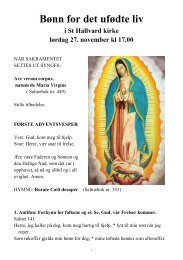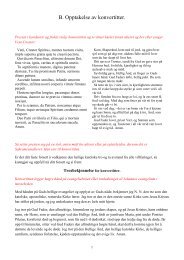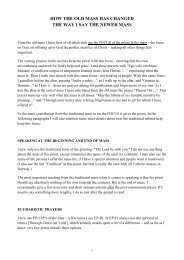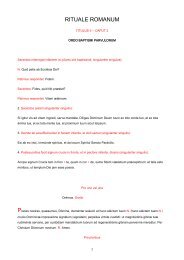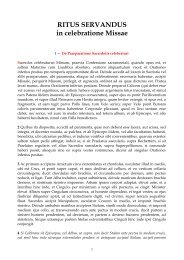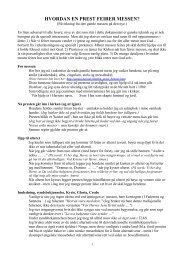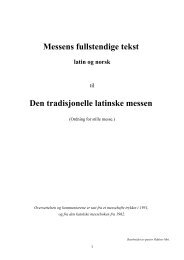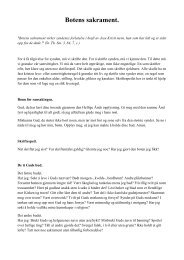oppgaven finner man i sin helhet her
oppgaven finner man i sin helhet her
oppgaven finner man i sin helhet her
You also want an ePaper? Increase the reach of your titles
YUMPU automatically turns print PDFs into web optimized ePapers that Google loves.
katolske rituser som hadde oppstått før dette. 37 Det har rådet (og råder fortsatt) en del<br />
misforståelser knyttet til den tridentinske messen; en utbredt feiloppfatning er at denne<br />
liturgien oppstod i forbindelse med Trient-konsilet, som en ny ritus.<br />
Pave Pius Vs missale var det første som ble offisielt utgitt av Vatikanet; det ble senere<br />
foretatt revisjoner som medførte relativt sekundære endringer på det praktiske plan –<br />
disse ble inkorporert i de påfølgende editio typica-utgavene av Missale Ro<strong>man</strong>um. (En<br />
editio typica er en offisiell ny, autorisert utgave fra Vatikanet som blir promulgert fra<br />
paven med et eget skriv; denne kan oppdateres i nye utgaver, som forblir versjoner av<br />
samme missale helt til neste editio typica.) P. Adrian Fortesque bekrefter dette i sitt<br />
klassiske liturgi-arkeologiske verk ”The Mass. A study of the Ro<strong>man</strong> liturgy” (1912):<br />
”Since the Council of Trent the history of the Mass is hardly anything but that of the<br />
composition and approval of new Masses. The scheme and all the fundamental parts<br />
remain the same. No one has thought of touching the venerable liturgy of the Ro<strong>man</strong> Mass,<br />
except by adding to it new Propers. T<strong>her</strong>e has not even been a new preface or a new<br />
Communicantes prayer. What has happened is an endless addition of Masses for new<br />
feasts.” 38<br />
Slik beskriver p. J. B. O´Connell den liturgiske messebokens historie i sitt verk ”The<br />
celebration of Mass. A study of the rubrics of the Ro<strong>man</strong> Missal”, som er en av de mest<br />
anerkjente referansene blant prester og katolske teologer (1964):<br />
”1. The Ro<strong>man</strong> Missal is the liturgical book which contains the rules to be followed, the<br />
prayers to be recited, and the acts to be accomplished, in the celebration of Mass according<br />
to the Ro<strong>man</strong> rite.<br />
2. The Missal, as we know it now, is the term of a long process of development that has<br />
gone on during nineteen centuries. In the early days of the Church´s existence, when<br />
solemn Mass was the typical Mass, the formulas of the Mass were scattered about in<br />
various books, to suit the convenience of those who employed them.<br />
(…)<br />
7. Missal of Pius V (1570). The council of Trent (1545-1563) decided that a revision of the<br />
liturgical books was necessary – owing to the diversity of usage which had arisen and to<br />
the influence of Protestantism on the liturgy (…) This Missal was the first Missal to be<br />
officially published by the Holy See.<br />
8. The new Missal did not introduce a new rite. Its compilation was a reform, and<br />
consisted in the codification of the traditional rubrics, in the correction of the texts, and in<br />
securing agreement between the Missal and the newly reformed Ro<strong>man</strong> Breviary.” (…) 39<br />
37 P. Adrian Fortescue: The Mass. A study of the Ro<strong>man</strong> liturgy, Preserving Christian Publications<br />
1912, s. 205-206<br />
38 Op. cit. s. 211<br />
39 p. J. B. O´Connell: The celebration of Mass. A study of the rubrics of the Ro<strong>man</strong> Missal, Bruce<br />
Publishing Company 1964, s. 8-10<br />
28<br />
28



